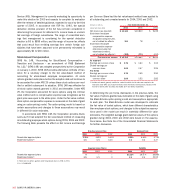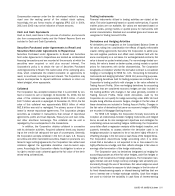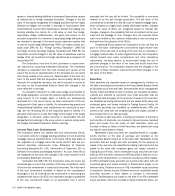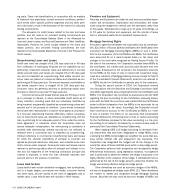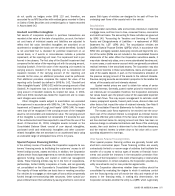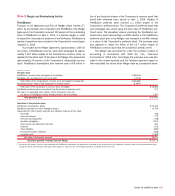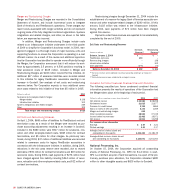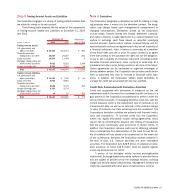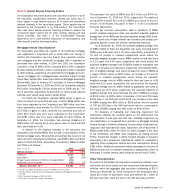Bank of America 2004 Annual Report Download - page 109
Download and view the complete annual report
Please find page 109 of the 2004 Bank of America annual report below. You can navigate through the pages in the report by either clicking on the pages listed below, or by using the keyword search tool below to find specific information within the annual report.
not required to be consolidated by the seller or investors in the entity.
For non-QSPE structures or VIEs, the Corporation assesses whether it
is the primary beneficiary of the entity. In accordance with FIN 46R, the
primary beneficiary is the party that consolidates a VIE based on its
assessment that it will absorb a majority of the expected losses or
expected residual returns of the entity, or both. For additional infor-
mation on other special purpose financing entities, see Note 8 of the
Consolidated Financial Statements.
Income Taxes
The Corporation accounts for income taxes in accordance with SFAS
No. 109, “Accounting for Income Taxes” (SFAS 109), resulting in two
components of Income Tax Expense: current and deferred. Current
income tax expense approximates taxes to be paid or refunded for
the current period. Deferred income tax expense results from
changes in deferred tax assets and liabilities between periods. These
gross deferred tax assets and liabilities represent decreases or
increases in taxes expected to be paid in the future because of future
reversals of temporary differences in the bases of assets and liabili-
ties as measured by tax laws and their bases as reported in the finan-
cial statements.
Deferred tax assets have also been recognized for net operating
loss carryforwards and tax credit carryforwards. Valuation allowances
are then recorded to reduce deferred tax assets to the amounts man-
agement concludes are more likely than not to be realized.
Retirement Benefits
The Corporation has established qualified retirement plans covering
substantially all full-time and certain part-time employees. Pension
expense under these plans is charged to current operations and con-
sists of several components of net pension cost based on various
actuarial assumptions regarding future experience under the plans.
In addition, the Corporation has established unfunded supple-
mental benefit plans and supplemental executive retirement plans for
selected officers of the Corporation and its subsidiaries that provide
benefits that cannot be paid from a qualified retirement plan due to
Internal Revenue Code restrictions. These plans are nonqualified
under the Internal Revenue Code and assets used to fund benefit
payments are not segregated from other assets of the Corporation;
therefore, in general, a participant’s or beneficiary’s claim to benefits
under these plans is as a general creditor.
In addition, the Corporation has established several postretire-
ment healthcare and life insurance benefit plans.
Other Comprehensive Income
The Corporation records unrealized gains and losses on AFS
Securities, foreign currency translation adjustments, related hedges
of net investments in foreign operations, and gains and losses on
cash flow hedges in Accumulated OCI. Gains and losses on AFS
Securities are reclassified to Net Income as the gains or losses are
realized upon sale of the securities. Other-than-temporary impairment
charges are reclassified to Net Income at the time of the charge.
Translation gains or losses on foreign currency translation adjust-
ments are reclassified to Net Income upon the sale or liquidation of
investments in foreign operations. Gains or losses on derivatives
accounted for as hedges are reclassified to Net Income in the same
caption of the Consolidated Statement of Income that was affected
by the hedged item.
Earnings Per Common Share
Earnings per Common Share is computed by dividing Net Income
Available to Common Shareholders by the weighted average common
shares issued and outstanding. For Diluted Earnings per Common
Share, Net Income Available to Common Shareholders can be
affected by the conversion of the registrant’s convertible preferred
stock. Where the effect of this conversion would have been dilutive,
Net Income Available to Common Shareholders is adjusted by the
associated preferred dividends. This adjusted Net Income is divided
by the weighted average number of common shares issued and out-
standing for each period plus amounts representing the dilutive
effect of stock options outstanding, restricted stock units and the
dilution resulting from the conversion of the registrant’s convertible
preferred stock, if applicable. The effects of convertible preferred
stock, restricted stock units and stock options are excluded from the
computation of diluted earnings per common share in periods in
which the effect would be antidilutive. Dilutive potential common
shares are calculated using the treasury stock method.
Foreign Currency Translation
Assets, liabilities and operations of foreign branches and sub-
sidiaries are recorded based on the functional currency of each
entity. For certain of the foreign operations, the functional currency
is the local currency, in which case the assets, liabilities and opera-
tions are translated, for consolidation purposes, at current exchange
rates from the local currency to the reporting currency, the U.S.
dollar. The resulting unrealized gains or losses are reported as a
component of Accumulated OCI on an after-tax basis. When the for-
eign entity is not a free-standing operation or is in a hyperinflation-
ary economy, the functional currency used to measure the financial
statements of a foreign entity is the U.S. dollar. In these instances,
the resulting realized gains or losses are included in income.
Co-Branding Credit Card Arrangements
The Corporation has co-brand arrangements that entitle a cardholder
to receive benefits based on purchases made with the card. These
arrangements have remaining terms generally not exceeding five
years. The Corporation may pay one-time fees which would be
deferred ratably over the term of the arrangement. The Corporation
makes monthly payments to the co-brand partners based on the vol-
ume of cardholders’ purchases and on the number of points awarded
to cardholders. Such payments are expensed as incurred and are
recorded as contra-revenue.
108 BANK OF AMERICA 2004






